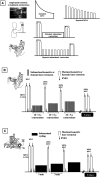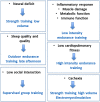Measuring objective fatigability and autonomic dysfunction in clinical populations: How and why?
- PMID: 37065809
- PMCID: PMC10101442
- DOI: 10.3389/fspor.2023.1140833
Measuring objective fatigability and autonomic dysfunction in clinical populations: How and why?
Abstract
Fatigue is a major symptom in many diseases, often among the most common and severe ones and may last for an extremely long period. Chronic fatigue impacts quality of life, reduces the capacity to perform activities of daily living, and has socioeconomical consequences such as impairing return to work. Despite the high prevalence and deleterious consequences of fatigue, little is known about its etiology. Numerous causes have been proposed to explain chronic fatigue. They encompass psychosocial and behavioral aspects (e.g., sleep disorders) and biological (e.g., inflammation), hematological (e.g., anemia) as well as physiological origins. Among the potential causes of chronic fatigue is the role of altered acute fatigue resistance, i.e. an increased fatigability for a given exercise, that is related to physical deconditioning. For instance, we and others have recently evidenced that relationships between chronic fatigue and increased objective fatigability, defined as an abnormal deterioration of functional capacity (maximal force or power), provided objective fatigability is appropriately measured. Indeed, in most studies in the field of chronic diseases, objective fatigability is measured during single-joint, isometric exercises. While those studies are valuable from a fundamental science point of view, they do not allow to test the patients in ecological situations when the purpose is to search for a link with chronic fatigue. As a complementary measure to the evaluation of neuromuscular function (i.e., fatigability), studying the dysfunction of the autonomic nervous system (ANS) is also of great interest in the context of fatigue. The challenge of evaluating objective fatigability and ANS dysfunction appropriately (i.e.,. how?) will be discussed in the first part of the present article. New tools recently developed to measure objective fatigability and muscle function will be presented. In the second part of the paper, we will discuss the interest of measuring objective fatigability and ANS (i.e. why?). Despite the beneficial effects of physical activity in attenuating chronic fatigue have been demonstrated, a better evaluation of fatigue etiology will allow to personalize the training intervention. We believe this is key in order to account for the complex, multifactorial nature of chronic fatigue.
Keywords: autonomic nervous system; baroreflex; cardiopulmonary exercise testing; deconditioning; fatigue; heart rate variability; neuromuscular function monitoring.
© 2023 Millet, Bertrand, Lapole, Féasson, Rozand and Hupin.
Conflict of interest statement
GM is a member of the Myocene Scientific Advisory Board. The remaining authors declare that the research was conducted in the absence of any commercial or financial relationships that could be construed as a potential conflict of interest.
Figures





Similar articles
-
Fatigability and the Role of Neuromuscular Impairments in Chronic Kidney Disease.Am J Nephrol. 2022;53(4):253-263. doi: 10.1159/000523714. Epub 2022 Mar 28. Am J Nephrol. 2022. PMID: 35344954 Free PMC article. Review.
-
Neuromuscular fatigue during exercise: Methodological considerations, etiology and potential role in chronic fatigue.Neurophysiol Clin. 2017 Apr;47(2):95-110. doi: 10.1016/j.neucli.2017.03.002. Epub 2017 Apr 20. Neurophysiol Clin. 2017. PMID: 28434551 Review.
-
Skeletal Muscle Fatigability in Heart Failure.Front Physiol. 2019 Feb 21;10:129. doi: 10.3389/fphys.2019.00129. eCollection 2019. Front Physiol. 2019. PMID: 30846944 Free PMC article.
-
6-minute walk test as a measure of disease progression and fatigability in a cohort of individuals with RYR1-related myopathies.Orphanet J Rare Dis. 2018 Jul 3;13(1):105. doi: 10.1186/s13023-018-0848-9. Orphanet J Rare Dis. 2018. PMID: 29970108 Free PMC article.
-
Fatigue versus activity-dependent fatigability in patients with central or peripheral motor impairments.Neurorehabil Neural Repair. 2008 Mar-Apr;22(2):105-10. doi: 10.1177/1545968308315046. Neurorehabil Neural Repair. 2008. PMID: 18285599 Free PMC article. Review.
Cited by
-
Reduced rate of force development under fatigued conditions is associated to the decline in force complexity in adult males.Eur J Appl Physiol. 2024 Dec;124(12):3583-3591. doi: 10.1007/s00421-024-05561-9. Epub 2024 Jul 24. Eur J Appl Physiol. 2024. PMID: 39046485 Free PMC article.
-
Effects of a symptom-titrated exercise program on fatigue and quality of life in people with post-COVID condition - a randomized controlled trial.Sci Rep. 2024 Dec 16;14(1):30511. doi: 10.1038/s41598-024-82584-4. Sci Rep. 2024. PMID: 39681609 Free PMC article. Clinical Trial.
-
Multifactorial Influences on Oxygen Consumption Recovery Post-High-Intensity Exercise in Adults: A Case-Control Study.Medicina (Kaunas). 2025 Jul 3;61(7):1213. doi: 10.3390/medicina61071213. Medicina (Kaunas). 2025. PMID: 40731842 Free PMC article.
-
[Immunological aspects and stress regulation in fatigue].Bundesgesundheitsblatt Gesundheitsforschung Gesundheitsschutz. 2024 Nov;67(11):1222-1230. doi: 10.1007/s00103-024-03952-z. Epub 2024 Sep 26. Bundesgesundheitsblatt Gesundheitsforschung Gesundheitsschutz. 2024. PMID: 39325193 Free PMC article. Review. German.
-
Screening for postural orthostatic tachycardia syndrome using 24-hour electrocardiogram recording in patients with long coronavirus disease.Heart Rhythm O2. 2025 May 8;6(7):949-955. doi: 10.1016/j.hroo.2025.04.011. eCollection 2025 Jul. Heart Rhythm O2. 2025. PMID: 40734755 Free PMC article.
References
-
- National Comprehensive Cancer Network. Clinical practice guidelines in Oncology. Survivorship. (2021).
Publication types
LinkOut - more resources
Full Text Sources
Research Materials

